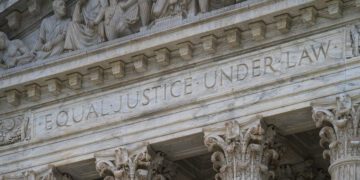By John F. Di Leo -
A July 2 article began as follows:
“A 25-year-old Arlington Heights man is accused of aggravated kidnapping and sexual abuse, among other charges, according to the Arlington Heights Police Department.”
In journalism, the leading paragraph is known as the “lede” – with its own distinctive spelling, perhaps to signify how important it is to the process of newswriting. The rule is that it summarizes the most important elements of the article, because, as writers hate to admit but know all too well, not all readers will read the whole thing.
The Pyramid Style
In journalism class, we are taught the pyramid format for hard news: cover as much as you can of the story, and organize the elements by importance, for two main reasons:
- Not everyone will read the entire story, so your job is to give them the key points right away, giving added detail throughout the piece, again, ordered by importance, and
- You don’t know how much of the story will actually be printed, and editors don’t have the time for surgical cuts, so they will only cut it by lopping off however much of the bottom doesn’t fit.
This was the biggest surprise I recall in the journalism classes I took in college (it wasn’t my major). In high school and college, I was accustomed to edits throughout a piece – marks off for run-on sentences, notes to tighten up or drop this paragraph or that, etc. – because teachers focus on helping make their students better writers.
By contrast, a newspaper editor’s job is to get that paper out, to meet that deadline. He doesn’t have time to teach you how to be a better writer. He counts on you already being a good writer, so he takes your article and fits it in the space he has.
Sometimes that means the whole piece fits. More often than not, one or two or three paragraphs have to go. Maybe half the article has to go. The pyramid style makes that easy: you just lop it off at the end.
You submit ten column inches, but we only have five inches of space? The bottom half of the story is scrapped; only the first half is printed. Simple. Quick
Internet publishing has changed this a bit, since we are no longer fighting for square inches of physical space, but the concept remains: In a news story, the pyramid style reigns, in both the classroom and the newsroom.
Most other kinds of writing are free of this very restrictive obligation. Op/Ed columnists and feature writers can use the pyramid if it works for them, but they are also given free rein to use other formats. An op/ed or feature can start off with one attention-grabber, then veer off into tangents, and tie it all up in a bow at the end. The money quote from the column might be at the beginning, might be in the middle, might be the very last line. Different approaches work for different writers, and appeal to different readers.
But no such flexibility exists – traditionally, anyway – for the news story. And this is where hidden, unexpected bias can arise.
The reporter gathers his information, whether on a recorder, a notepad, or his cellphone, and starts to organize it. He’s probably in a hurry, as he has a deadline to meet. In the internet age, it’s not even the old rush of getting to the street by evening or by the next morning; today, we want to publish online immediately, before someone else scoops us.
How, then, to organize that list of notes? How to prioritize them?
An Arlington Heights Assault
In the story with which we began, there was an assault in a wooded park. 25-year-old Chadane Gordon allegedly picked up a woman at some unstated social setting in the evening, insisted on walking her home in the early hours of the morning, and attacked her in the woods en route, at about 5:30am. Her screams were heard; the police caught the perpetrator, and charged him with multiple crimes such as aggravated battery and sexual assault. The woman was hospitalized for severe but non-life-threatening injuries. He was on mandated supervised release from prison at the time.
Subsequent news stories fleshed out more details, but that much was known by the reporter at the time the first story was published.
We now come to our challenge; what should be the focal point, the lead sentence? That's too much to fit in an opening paragraph, so the writer must use his personal judgment to identify the most important points to put in the lede, and to organize the story.
What would you call the most important aspect of this story?
- The fact that such a crime can occur in a community we like to think of as a safe suburb?
- The basic criminal blotter news that the crime occurred and who was involved? (as is customary, the victim is not named, but the perpetrator is).
- The nature of the attack? The article went into some detail on how and where he hit her, and listed the four preliminary charges in the case, right down to the exact times.
- Exactly where the victim met the attacker, and the place that he judged (fortunately incorrectly) to be out-of-the-way enough to get away with an attack, so that potential victims know to avoid such places in future?
The lessons we learn in journalism school don’t get into such detail. They can’t. This is a matter of judgment, and the right answer may depend on the publication and its readership.
I would argue, however, that there’s a political hot-button issue involved, one that was only introduced at the very end of the story. Only in the second-to-last line do we learn that “Gordon was on mandatory supervised release from the Illinois Department of Corrections at the time of the occurrence, according to police.”
Put Yourself in the Reporter’s Shoes.
Now then, if you were the reporter, how would you write the lede for this story?
- A local man was arrested for violent sexual assault in an Arlington Heights park.
- A woman’s screams were heard in time for police to catch a rapist in the act, in an Arlington Heights park.
- Chadane Gordon, on mandatory supervised release from Stateville for burglary and retail theft, was arrested for violent rape in an Arlington Heights park.
To be fair, I don’t mean to take issue with any individual reporter on this story. There are several articles about this incident today, in each of the local papers and in some radio news sources as well, and they all share some most of the key information… but each in slightly different order.
Some put the information that he’s a recent parolee from Stateville early in the piece; some put it at the bottom. The Sun Times and Tribune put it right in the headline. The Patch put it in the second line from the bottom. For those of us concerned with America’s crime problem, particularly in Chicagoland, that’s a perfect example of burying the lede.
Crime, Punishment, and Recidivism
Conservatives have been arguing for decades that America doesn’t so much have an explosion of criminals as we have a reluctance to punish those whom we convict. We can’t catch them for every crime they commit, and we can’t prosecute them for every crime we catch them at, so on the rare occasions when we are able to get a conviction, we really need to lock them up for a long time…
…but we don’t. When we finally do manage to get criminal convicted, we usually let him go for “time served”… or we give him a real sentence, then let him go on “mandatory supervised release” on the flimsiest of excuses: “The jails are too uncomfortable.” “He’s been behaving himself while in prison.” “He’s working to get his problems under control.” And now the newest: “There’s a coronavirus pandemic.”
The whole purpose of a criminal justice system is to identify those who violate the rights of their fellow citizens, and remove them from society. That’s why we have it. That’s why we have police, courtrooms, and jails. This isn’t all in place just to provide a false sense of security; it’s supposed to actually function. As hard as it may be to get a conviction, once we do, we have a right to expect that the villain be removed from our midst.
That’s why we have a government. That’s why we pay our taxes.
We understand that policing is hard. We understand that getting a conviction is hard.
But once you know a guy is a villain – once you’ve proven in court that he can’t be trusted in society – lock him up! Is that so much to ask?
If this guy had never been convicted before, we would have nobody else to blame for this crime but him. But Chadane Gordon had been identified, successfully prosecuted, and convicted already. He was sentenced. He was already in prison, at Stateville Correctional Center (that alone tells us that the state knew he was a bad guy; we don’t send buttercups to Stateville).
And then the state let him go, at 25, in good health, with all the strength it takes to overpower an innocent woman in a park.
This is the state’s fault. Why did Illinois let him go? Doesn’t Illinois have enough problems already? Do we really need to create more trouble, by unleashing more burglars and rapists into the community?
The Problem of Unintentional Bias
Now, back to our article, and the subject of our piece: the question of bias.
To me – an op/ed writer with a point of view – the most important element of this entire story is the fact that the perp is a recent parolee. That’s the lede. If I were writing headlines, it would be “Convicted Criminal Violates Parole with Violent Sexual Assault in Arlington Heights Park.”
Accurate, precise, unbiased. It’s just the facts.
To someone else’s view – someone raised with the opinion that everyone deserves unlimited second chances, the fact that he was a parolee isn’t important.
Some people are raised to believe that we’re all alike, that criminals only commit crimes because of bad luck, bad parenting, bad video games… so we should feel sorry for them. To them, it wasn’t bias to put the mention of his parole status at the bottom; it was no different from saying “prior to his move to Arlington Heights, he lived in Joliet,” or “the defendant's most recent job was as a janitor.”
This is the problem with identifying and eliminating bias in the newsmedia. Yes, there certainly is such a thing; yes, there is a conscious effort in many newsrooms (maybe even most) to give a conscious edge to one political side over another. Yes, there are Democrats in most newsrooms who intentionally skew their articles to favor their side of the aisle and make the Republican side look bad.
But that intentional bias is usually so obvious, it’s not a major problem, at least for intelligent readers. The reader sees the bias and discounts it, and moves on with his day.
The most dangerous kind of news bias, in my opinion, is the well-intentioned judgment of writers and editors with a different worldview than their readership – a frankly unamerican worldview, in fact.
When a writer has been surrounded since birth by a pop culture that lauds gang members as “cool music artists” – a school system that tells us capitalism is exploitative and religion is old-fashioned – a political class that insists the public trough is just there for everyone to feed at equally, and needs to be refilled constantly, like a cornucopia – how can we expect him to have good judgment about which aspects of a story are most important to the audience?
Intentional bias can be balanced by opening alternative media sources. Conservative talk radio balances against leftist newspapers; FoxNews and OAN provide balance against CNN and MSNBC.
But the subtle, unconscious bias of the newsman who doesn’t even realize his worldview is at odds with the American way of life is a far greater challenge.
Our problem isn’t just our news sources, it’s the factory system that feeds them – the leftist influence in our pop culture, and in the majority of our schools, publishing houses, even churches – that raises these writers from birth, poisoned by the leftist viewpoints, long before they ever set foot in a journalism class or newsroom.
We desperately need to return America to the values on which it was founded. The First Amendment was designed for a free people who valued their freedom; our precious First Amendment cannot be expected to function to our advantage when the institutions that it protects are all so terribly corrupted.
It’s on us, folks. Remember Ben Franklin’s admonition, upon stepping out of the Constitutional Convention and being asked, “What have you given us, sir?”
Came the reply: “A republic, madam, if you can keep it.”
Copyright 2020 John F. Di Leo
John F. Di Leo is a Chicagoland-based trade compliance trainer, transportation manager, writer and actor. His column has been found in Illinois Review since 2009.
Don’t miss an article! Use the free tool in the margin to sign up for Illinois Review’s free email notification service, so you always know when we publish new content!







